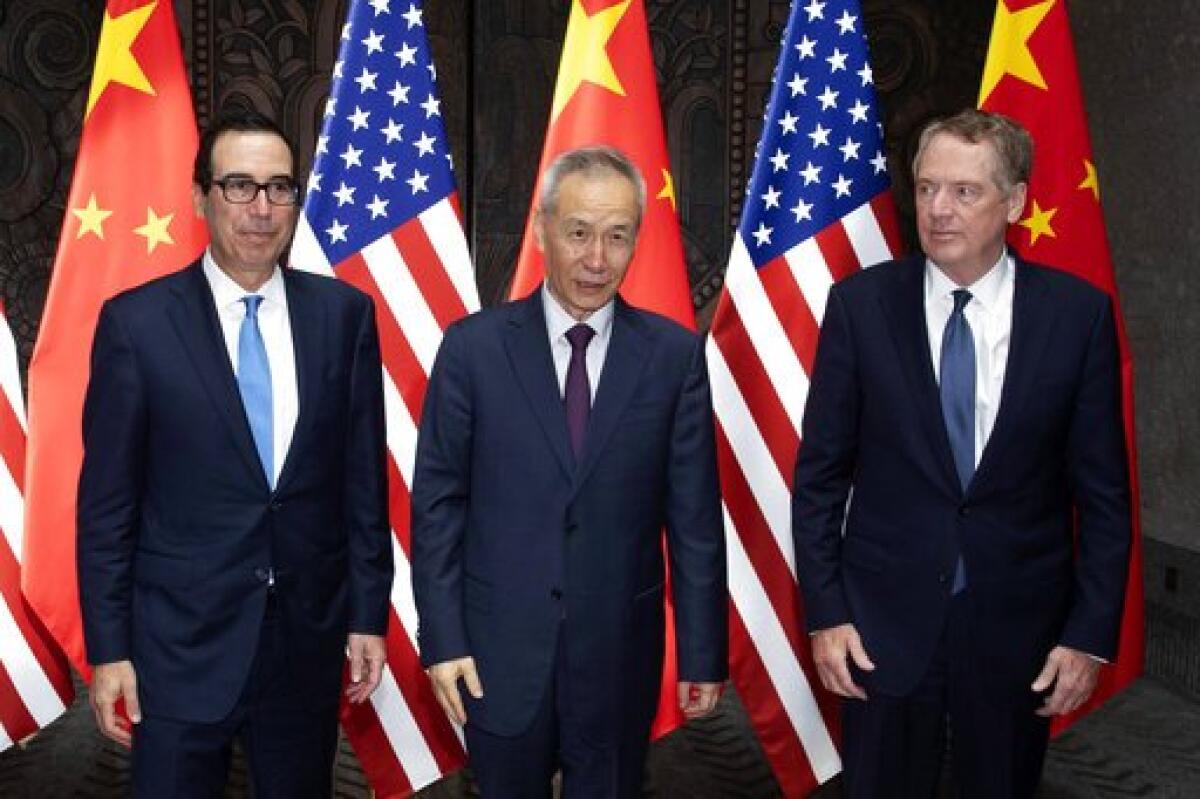China and U.S. to resume trade talks in Washington in October

- Share via
WASHINGTON — In agreeing to resume high-level trade talks in Washington next month, U.S. and Chinese officials rekindled hope Thursday that the two sides could deescalate tariffs and bilateral tensions that have shaken markets and the global economy.
But even as stocks rallied on the news, analysts were left wondering what would be different this time that would enable a breakthrough after many prior rounds of talks ended without a deal and eventually more tariffs slapped on each other’s goods.
The two sides have been divided on fundamental issues involving China’s government-controlled practices that Washington regards as detrimental to American companies and its economic prosperity, including cybertheft, technology-transfer requirements and subsidies to state-owned firms.
“It’s hard to see what precisely has changed in the tenor of conversations and in terms of actions, what the positive movement would be,” said Charles Freeman, senior vice president for Asia at the U.S. Chamber of Commerce.
Still, he said, it was critical for the two sides to get back to table. “At a minimum it’s important to take baby steps — if not a more active approach — to start to inspire confidence on both sides. Clearly both sides know the stakes are high.”
The agreement to resume negotiations came together Wednesday night, Washington time, when U.S. Trade Representative Robert Lighthizer and Treasury Secretary Steve T. Mnuchin talked by phone with China’s lead negotiator, Vice Premier Liu He.
China’s Commerce Ministry said in a statement that top trade officials from both sides would meet in early October, but Lighthizer’s office, which is overseeing the talks for President Trump, said only that the parties had agreed to hold meetings in Washington “in the coming weeks.”
Both sides noted that deputy-level discussions would take place in mid-September. The USTR said they would “lay the ground work for meaningful progress.”
China had a somewhat different spin on the advance work. “The two sides agreed that they should work together and take practical actions to create favorable conditions for consultations,” China’s Commerce statement read.
Analysts said that, for the Chinese, that probably means they want the Trump administration to address the deescalation of various tariffs placed on imported goods from China.
Over the last year and half, Trump has imposed higher tariffs on more than $360 billion of Chinese merchandise. The latest round, 15% taxes on $110 billion of shoes, clothes, electronics and other consumer goods, took effect on Sunday.
Trump has announced two more rounds of tariffs to pressure the Chinese to make concessions, to buy U.S. farm goods, cut its trade surplus and address structural economic issues. On Oct. 1, previously imposed 25% additional tariffs on $250 billion of mostly industrial products from China will rise to 30%. And on Dec. 15, 15% tariffs will be added to another roughly $170 billion worth of China-made consumer products, including cell phones and laptops.
China, for its part, has announced retaliatory tariff increases of 5% to 10% on $75 billion of U.S. products, including oil, soybeans and cotton. Beijing also said that on Dec. 15 it would reimpose tariff hikes that had been suspended on American-produced cars and car parts.
Analysts said it was possible that tariffs slated to take effect Oct. 1 and Dec. 15 could be put on hold if talks look promising.
The Chinese have made clear that they want a removal of tariffs and relaxation of supplier restrictions that Trump has placed on Huawei Technologies in the name of national security. Huawei is one of China’s top global technology firms and is the world’s largest manufacturer of telecommunications equipment.
Experts said it wasn’t clear to them what Lighthizer and the U.S. side were willing to offer, or what it considered to be “meaningful progress,” after talks broke down in May and the U.S. team accused China of reneging on previously made agreements.
Lighthizer has pushed for market access and other structural changes in Beijing’s industrial policies that would level the playing field for American firms. He has insisted that China’s agreement must be enforceable, but Beijing has balked at U.S. pressure to enshrine changes in national law.
Lighthizer and Mnuchin last met with Liu and the Chinese negotiating team in late July in Shanghai. But there was little progress made, and upon return from China, Trump promptly announced 10% higher tariffs on about $300 billion of mostly consumer goods from China. Last month he ratcheted that up to 15% and also told U.S. firms to leave China.
More to Read
Inside the business of entertainment
The Wide Shot brings you news, analysis and insights on everything from streaming wars to production — and what it all means for the future.
You may occasionally receive promotional content from the Los Angeles Times.











